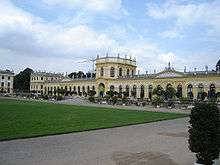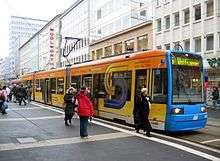Kassel
| Kassel | |||
|---|---|---|---|
 Kassel Hercules at Bergpark Wilhelmshöhe, landmark of the city (UNESCO World Heritage) | |||
| |||
 Kassel | |||
| Coordinates: 51°19′N 9°30′E / 51.317°N 9.500°ECoordinates: 51°19′N 9°30′E / 51.317°N 9.500°E | |||
| Country | Germany | ||
| State | Hesse | ||
| Admin. region | Kassel | ||
| District | Urban district | ||
| Government | |||
| • Mayor | Christian Geselle (SPD) | ||
| Area | |||
| • City | 107 km2 (41 sq mi) | ||
| Elevation | 167 m (548 ft) | ||
| Population (2017-12-31)[1] | |||
| • City | 200,736 | ||
| • Density | 1,900/km2 (4,900/sq mi) | ||
| • Metro | 450,000 | ||
| Time zone | CET/CEST (UTC+1/+2) | ||
| Postal codes | 34001–34134 | ||
| Dialling codes | 0561 | ||
| Vehicle registration | KS | ||
| Website | www.stadt-kassel.de | ||
Kassel (German pronunciation: [ˈkasl̩] (![]()
History
_1572.jpg)
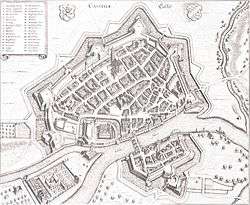

Kassel was first mentioned in 913 AD, as the place where two deeds were signed by King Conrad I. The place was called Chasella or Chassalla and was a fortification at a bridge crossing the Fulda river. There are several - yet unproven - assumptions of the name's origin. It could be derived from the ancient Castellum Cattorum, a castle of the Chatti, a German tribe that had lived in the area since Roman times. Another assumption is a portmanteau from Frankonian "cas" - valley or recess and "sali" - hall or service building, which can be interpreted as (town)hall in a valley.
A deed from 1189 certifies that Cassel had city rights, but the date when they were granted is not known.
In 1567, the Landgraviate of Hesse, until then centered in Marburg, was divided among four sons, with Hesse-Kassel (or Hesse-Cassel) becoming one of its successor states. Kassel was its capital and became a centre of Calvinist Protestantism in Germany. Strong fortifications were built to protect the Protestant stronghold against Catholic enemies. Secret societies, such as Rosicrucianism flourished, with Christian Rosenkreutz’s work Fama Fraternitis first published in 1617. In 1685, Kassel became a refuge for 1,700 Huguenots who found shelter in the newly established borough of Oberneustadt. Landgrave Charles, who was responsible for this humanitarian act, also ordered the construction of the Oktagon and of the Orangerie. In the late 18th Century, Hesse-Kassel became infamous for selling mercenaries (Hessians) to the British crown to help suppress the American Revolution and to finance the construction of palaces and the Landgrave’s opulent lifestyle.
In the early 19th century, the Brothers Grimm lived in Kassel. They collected and wrote most of their fairy tales there. At that time, around 1803, the Landgraviate was elevated to a Principality and its ruler to Prince-elector. Shortly after, it was annexed by Napoleon and in 1807 it became the capital of the short-lived Kingdom of Westphalia under Napoleon's brother Jérôme. The Electorate was restored in 1813.
Having sided with Austria in the Austro-Prussian War to gain supremacy in Germany, the principality was annexed by Prussia in 1866. The Prussian administration united Nassau, Frankfurt and Hesse-Kassel into the new Prussian province of Hesse-Nassau. Kassel ceased to be a princely residence, but soon developed into a major industrial centre, as well as a major railway junction. Henschel & Son, the largest railway locomotive manufacturer in Germany at the end of the nineteenth century, was based in Kassel.
In 1870, after the Battle of Sedan, Napoleon III was sent as a prisoner to the Wilhelmshöhe Palace above the city. During World War I the German military headquarters were located in the Wilhelmshöhe Palace. In the late 1930s Nazis destroyed Heinrich Hübsch's Kassel Synagogue.
During World War II, Kassel was the Headquarters for Germany's Wehrkreis IX, and a local subcamp of Dachau concentration camp provided forced labour for the Henschel facilities, which included tank production plants.[2] The most severe bombing of Kassel in World War II destroyed 90% of the downtown area, some 10,000 people were killed, and 150,000 were made homeless. Most of the casualties were civilians or wounded soldiers recuperating in local hospitals, whereas factories survived the attack generally undamaged. Karl Gerland replaced the regional Gauleiter, Karl Weinrich, soon after the raid.
The Allied ground advance into Germany reached Kassel at the beginning of April 1945. The US 80th Infantry Division captured Kassel in bitter house-to-house fighting during 2–4 April 1945, which included numerous German panzer-grenadier counterattacks, and resulted in further widespread devastation to bombed and unbombed structures alike.[3]
Post-war, most of the ancient buildings were not restored, and large parts of the city area were completely rebuilt in the style of the 1950s. A few historic buildings, however, such as the Museum Fridericianum (see below), were restored. In 1949, the interim parliament ("Parlamentarischer Rat") eliminated Kassel in the first round as a city to become the provisional capital of the Federal Republic of Germany (Bonn won). In 1964, the town hosted the fourth Hessentag state festival (again in 2013). In 1972 the Chancellor of West Germany Willy Brandt and the Prime Minister of the German Democratic Republic Willy Stoph met in Wilhelmshöhe Palace for negotiations between the two German states. In 1991 the central rail station moved from "Hauptbahnhof" (English: main station) (today only used for regional trains) to "Kassel-Wilhelmshöhe".
Culture
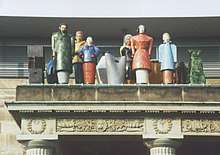
In 1558, the first German observatory was built in Kassel, followed in 1604 by the Ottoneum, the first permanent German theatre building. The old building is today the Natural History Museum, and the now-called Staatstheater Kassel is located in a nearby building that was constructed in the 1950s. Since 1927, Kassel has been home to Bärenreiter, one of the world's most important music publishers.
Since 1955 the Documenta, an international exhibition of modern and contemporary art, has been held regularly in Kassel. The Documenta now takes place every 5 years. The most recent exhibition, documenta 14 is being held from June to September, 2017. As a result of the Documenta 6 (1977), Kassel became the first town in the world to be illuminated by laser beams at night (Laserscape, by artist Horst H. Baumann). This laser installation is nowadays still visible at weekends. Other Documenta remnants (mainly sculptures) can be found in many places in Kassel; among those the "7000 Oaks", a work of land art by the German artist Joseph Beuys.
Demographics
| Rank | Nationality | Population (2017) |
|---|---|---|
| 1 | 8,466 | |
| 2 | 2,012 | |
| 3 | 1,893 | |
| 4 | 1,327 | |
| 5 | 1,167 | |
| 6 | 902 | |
| 7 | 816 | |
| 8 | 808 | |
| 9 | 778 | |
| 10 | 723 | |
| 11 | 716 |
Sights
The bombing raids of 1943 destroyed 90% of the city centre. The city was almost completely rebuilt during the 1950s and is a combination of renovated or reconstructed old buildings and architecture of the 1950s. Outside the city centre, the suburbs are dominated by 19th-century architecture. The oldest monument is the Druselturm; the Brüderkirche and the Martinskirche are also, in part, of medieval origin. The towers of the Martinskirche are from the 1950s.
Bergpark Wilhelmshöhe
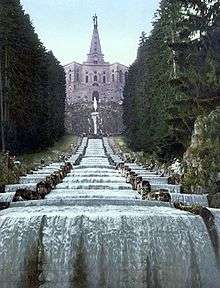
The complex includes Wilhelmshöhe Palace (with the Antiquities Collection and Old Masters), the Hercules monument, and the Lions Castle. Wilhelmshöhe Palace above the city, was built in 1786 by landgrave Wilhelm IX of Hesse-Kassel. The palace is now a museum and houses an important collection of Graeco-Roman antiques and a fine gallery of paintings comprising the second largest collection of Rembrandts in Germany. It is surrounded by the beautiful Bergpark Wilhelmshöhe with many appealing sights. The complex was named a UNESCO World Heritage Site in 2013.[4]
The Hercules monument is a huge octagonal stone structure carrying a giant replica of Hercules "Farnese" (now at Museo Archeologico Nazionale in Naples, Italy). From its base down to Wilhelmshöhe Palace runs a long set of artificial cascades which delight visitors during the summer months. Every Sunday and Wednesday afternoon at 14:30 (from May until October) the famous water features take place. They start at the Oktagon and during a one-hour walk through the park visitors can follow the water's way until they reach the lake of the Wilhelmshöhe Palace, where a fountain of about 50 metres (160 ft) marks the end of the spectacle.
The Löwenburg ("Lions Castle") is a replica of a medieval castle, also built during the reign of Wilhelm IX. After the Franco-Prussian War of 1870/71 Napoléon III was imprisoned in Wilhelmshöhe. In 1918 Wilhelmshöhe became the seat of the German Army High Command (OHL): it was there that the military commanders Hindenburg and Ludendorff prepared the German capitulation.
Staatspark Karlsaue (Karlsaue Park)
Another large park and also part of the European Garden Heritage Network is the Karlsaue along the Fulda River. Established in the 16th century, it is famous for the Orangerie, a palace built in 1710 as a summer residence for the landgraves. Today, the Orangerie contains the Museum of Astronomy and Technology, with a scale model of the Solar System spanning the entire park and beyond. In addition, the Park Schönfeld contains a small, municipal botanical garden, the Botanischer Garten Kassel.
Art museums
Europe's first public museum, the Museum Fridericianum was founded in 1779. By the end of the 19th century the museum held one of the largest collections in the world of watches and clocks. Other art museums in Kassel include:
- Wilhelmshöhe Palace (Antiquities Collection and Old Masters: Albrecht Dürer, Rubens, Rembrandt, Frans Hals, Anthony van Dyck)
- New Gallery (Tischbein family, Joseph Beuys)
- Hessisches Landesmuseum closed, under renovation until 2012 (with a world-famous wallpaper collection).
Other museums
- Museum of Natural History (in the Ottoneum-building)
- Museum of physics and astronomy in the Orangerie
- Marmorbad (marble bath) in the Orangerie
- Caricatura (in the Hauptbahnhof Kassel)
- Museum of Local History
- Tram-Museum Kassel
- Technical Museum and Henschel Museum
- Louis Spohr Museum (classical music composer)
- Brothers Grimm Museum in the Bellevue Palace[5] (closed)
- Museum for Sepulchral Culture
- Museum of the Brothers Grimm (known as Grimmwelt Kassel) [6]
- Museum of Modern Art (Neue Gallerie) [7]
- Gemäldegallerie Kassel in the Wilhelmshöhe Palace (Schloss Wilhelmshöhe) [8]
- Botanical Island (Insel Siebenbergen) [9]
Sports
Hessen Kassel is the football club in the city, who plays in the Hessenliga after being relegated from the Regionalliga Südwest in the 2017/2018 season. The city's own football stadium, the Auestadion was built in 1953 and is able to hold 18,737 people. It is located in the south of Kassel at the quarter Südstadt, next to the Karlsaue.
Kassel has a long ice hockey tradition.[10] The team, the Kassel Huskies, was active from 1977 to 2010. They were founding members of the DEL in 1994, belonging to the league from 1994-2006 and again from 2008-2010. In 1997, they were runners-up in the championship play-offs, losing to Adler Mannheim and reached the semi-finals on three more occasions. The Huskies ran into financial difficulties and dissolved in 2010.[10] The "Young Huskies", which is a junior and youth hockey club, decided to enter a men's team in the Hessenliga.[10] This is the fifth division and the lowest men's competition in the state of Hesse.[10] The new club was expecting no more than 3,000 supporters for the first home game in the Hessenliga.[10] However, they had over 5,000 supporters come to watch.[10]
Transport
Kassel has seven tram lines (1, 3, 4, 5, 6, 7, 8), with trams arriving usually every 15 minutes. The city also operates a light rail Stadtbahn network called RegioTram using Regio Citadis low-floor trams which run on both tram and main line railway tracks with three lines (RT1, RT4, RT5). Moreover, a number of low-floor buses complete the Kassel public transport system. The introduction of low-floor buses led to the development of the Kassel kerb which improves the accessibility at bus stops.
The city is connected to the national rail network at two stations, Kassel Central, and Kassel-Wilhelmshöhe. The traditional central station (Hauptbahnhof) has been reduced to the status of a regional station since the opening of the Hanover-Würzburg high-speed rail line in 1991 and its station (Kassel-Wilhelmshöhe) on the high-speed line at which the InterCityExpress (ICE) and InterCity services call.
Kassel is connected to the motorways A 7, A 49 and A 44.
The city is served by Kassel Calden Airport.
Education and research
University of Kassel
The University of Kassel was founded in 1971, and is the newest university in the state of Hessen. The University offers twelve international master's programs as well as two short-term international programs, the Summer University and the Winter University. The Kunsthochschule Kassel is also part of the university.
Other institutions
- Kassel School of Medicine (KSM)
- Fraunhofer-Institut für Windenergie und Energiesystemtechnik (IWES), former Institut für Solare Energieversorgungstechnik (ISET)
- Fraunhofer-Institut für Bauphysik (IBP) Projektgruppe Kassel
- Forschungszentrum für Informationstechnik-Gestaltung (ITeG)
- International Center for Development and Decent Work (ICDD)[11]
- Internationales Zentrum für Hochschulforschung Kassel (INCHER)
- Zentrum für Umweltbewusstes Bauen (ZUB)
- Center for Interdisciplinary Nanostructure Science and Technology (CINSaT)
- AG Friedensforschung
Associations
- Volksbund Deutsche Kriegsgräberfürsorge German War Graves Commission
- Gesellschaft für Christlich-Jüdische Zusammenarbeit Kassel
- Spitzenverband der landwirtschaftlichen Sozialversicherung
- Deutsche Rentenversicherung Hessen
- Industrie- und Handelskammer Kassel (Chamber of Commerce Kassel)
Courts
Several courts are located in Kassel, including:
- Federal Social Court of Germany (Bundessozialgericht)
- Hessischer Verwaltungsgerichtshof (Administration Court of Hesse)
- Hessisches Finanzgericht
- Sozialgericht Kassel (Social Court Kassel)
- Arbeitsgericht Kassel (Employment Court Kassel)
- Verwaltungsgericht Kassel
- Oberlandesgericht Frankfurt/Main in Kassel
- Landgericht Kassel (Regional Court Kassel)
- Amtsgericht Kassel and Staatsanwaltschaft Kassel (Local Court Kassel)
Notable people

- Valerius Cordus (1515-1544) physician and botanist, authored pharmacopoeias and herbals.
- William IV, Landgrave of Hesse-Kassel (1532-1592)
- Landgravine Charlotte of Hesse-Kassel (1627-1686)
- Maria Amalia of Courland (1653-1711), noblewoman, participated in creation of park at Karlsaue
- Simon Louis du Ry (1726-1799), architect
- Rudolf Erich Raspe (1736 – 1794), a University of Kassel librarian who fled to England after embezzling significant funds from Frederick II, Landgrave of Hesse-Kassel, and wrote (or compiled) The Surprising Adventures of Baron Munchhausen
- Prince Charles of Hesse-Kassel (1744-1836)
- Prince Frederick of Hesse-Kassel (1747-1837)
- Gertrud Elisabeth Mara (1749-1833), operatic soprano
- Georg Friedrich Sartorius (1765-1828), research historian and economist
- Louis Spohr (1784-1859), 19th-century composer and violinist, who is commemorated by a museum in the city
- Jérôme Bonaparte (1784-1860), brother of Napoleon Bonaparte, lived in Kassel while he was king of Westphalia
- The Brothers Grimm, Jacob (1785–1863) and Wilhelm Grimm (1786–1859), academics, linguists, cultural researchers, and authors who collected folklore and published several collections as Grimms' Fairy Tales
- HSH Princess Augusta of Hesse-Kassel (1797-1889), Princess and Landgravine of Hesse-Kassel, consort to Field Marshal HRH The Prince Adolphus Frederick, Duke of Cambridge
- Friedrich Armand Strubberg (1806–1889), merchant, physician, colonist in North America, direct descendant of Frederick I of Sweden
- Albrecht Rosengarten (1809-1893), architect famous for synagogue buildings in Central Europe
- Justus Carl Hasskarl (1809-1894), botanist specialising in Pteridophytes, Bryophytes, and Spermatophytes
- Louise of Hesse-Kassel (1811-1898), princess of Hesse-Kassel, later queen consort of King Christian IX of Denmark
- Helmut Kollars (born 1968), writer and illustrator
- Paul Reuter (1816–1899), founder of the Reuters news agency
- Israel Meyer Japhet (1818–1892) choral director in Frankfurt am Main
- Carl Friedrich Claus (1827-1900), chemist
- Adolf Eugen Fick (1829–1901), physiologist
- Hugo Wilhelm Arthur Nahl (1833-1899), artist who designed the Seal of California
- Lucien Scheler (1902–1999), French poet, writer, and publisher
- Jakob Stilling (1842-1915), ophthalmologist, son of Benedict Stilling, surgeon, and brother of Heinrich Stilling, pathologist
- Philipp Scheidemann (1865–1939), briefly Germany's Chancellor after the First World War
- Andreas Dippel (1866-1932), operatic tenor
- Carl Kaiserling (1869-1942), pathologist
- Franz Rosenzweig (1886–1929), philosopher
- F. W. Murnau (1888–1931), movie director in the silent era
- Helmut Hasse (1898–1979), fundamental theorist in algebra and number theory
- Arnold Bode (1900-1977), architect, painter, designer, and founder of the documenta
- Leni Junker (1905-1997), athlete who competed mainly in the 100 metres sprint
- Otto Sander (30 June 1941 – 12 September 2013), German film, theater, and voice actor
- Yona Melnik (born 1949), Israeli Olympic judoka
- Hubertus Meyer-Burckhardt (born 1956), German television journalist and talk show host
- Barbara Rudnik (27 July 1958 - 23 May 2009), German actress
- Meryem Sahra Uzerli (born 1982), Turkish-German actress
- Annika Mehlhorn (born 1983), German butterfly and medley swimmer, who competed in the 2004 Summer Olympics
- Milky Chance (present), German folk duo
- Yunus Mallı (born 1992), Turkish footballer

International relations
Kassel is twinned with:
|
See also
References
Notes
- ↑ "Bevölkerung der hessischen Gemeinden". Hessisches Statistisches Landesamt (in German). September 2018.
- ↑ Edward Victor. Alphabetical List of Camps, Subcamps and Other Camps.www.edwardvictor.com/Holocaust/List %20 of % 20 camps. htm
- ↑ Stanton, Shelby, World War II Order of Battle: An Encyclopedic Reference to U.S. Army Ground Forces from Battalion through Division, 1939-1946, Stackpole Books (Revised Edition 2006), p. 150
- ↑ "Sites in Germany and Italy bring to 19 the number of sites inscribed on the World Heritage List this year". UNESCO World Heritage Organization. 2013-06-23. Retrieved 9 July 2013.
- ↑ "Brueder Grimm-Museum Kassel". Retrieved 9 July 2013.
- ↑ "Startseite: GRIMMWELT". www.grimmwelt.de. Retrieved 4 May 2017.
- ↑ "neue galerie - Museumslandschaft Hessen Kassel". www.museum-kassel.de. Retrieved 4 May 2017.
- ↑ "schloss wilhelmshöhe - Museumslandschaft Hessen Kassel". www.museum-kassel.de. Retrieved 4 May 2017.
- ↑ "insel siebenbergen - Museumslandschaft Hessen Kassel". www.museum-kassel.de. Retrieved 4 May 2017.
- 1 2 3 4 5 6 "German hockey team skates from financial brink back to rink". Deutsche Welle. March 20, 2011. Retrieved March 21, 2011.
- ↑ "Archived copy". Archived from the original on 2015-02-11. Retrieved 2015-02-09.
- ↑ "Ramat Gan Sister Cities". Archived from the original on March 7, 2008. Retrieved April 6, 2008.
- ↑ "Ramat Gan Sister Cities".
Bibliography
External links
| Wikimedia Commons has media related to Kassel. |
| Wikivoyage has a travel guide for Kassel. |
- Kassel City Panoramas - Panoramic views and Virtual Tours
- Official website
- Kassel Tourist Board

- University of Kassel
- Street Crime Mapping Kassel 2009
- Video of the waterfeatures



